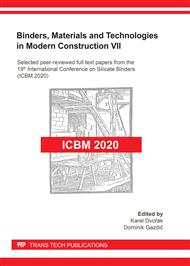[1]
M.Á. Climent-Llorca, M. Miró-Oca, P. Poveda-Martínez, J. Ramis-Soriano, Use of Higher-Harmonic and Intermodulation Generation of Ultrasonic Waves to Detecting Cracks due to Steel Corrosion in Reinforced Cement Mortar, Int. J. Concr. Struct. Mater. 14(1) (2020).
DOI: 10.1186/s40069-020-00432-x
Google Scholar
[2]
B. Kucharczyková, B. et al. Evaluation of Shrinkage, Mass Changes and Fracture Properties of Fine-aggregate Cement-based Composites during Ageing, Procedia Eng. 190 (2017) 357-364.
DOI: 10.1016/j.proeng.2017.05.349
Google Scholar
[3]
M. Matysik et al. The effect of concrete quality on the acoustic emission parameters during three-point bending fracture test, Adv. Mater. 897 (2014) 149-152.
DOI: 10.4028/www.scientific.net/amr.897.149
Google Scholar
[4]
K. Scrivener, R. Kirkpatrick, Innovation in Use and Research on Cementitious Material, Cem Concr Res. 38(2) (2008) 128-136.
Google Scholar
[5]
S. Majhi, A. Mukherjee, N.V. George, B. Uy, Corrosion detection in steel bar: A time-frequency approach, NDT E Int. 107 (2019).
DOI: 10.1016/j.ndteint.2019.102150
Google Scholar
[6]
A. Karozou, S. Konopisi, E. Pavlidou, M. Stefanidou, Long-term behavior and durability of alkali-activated clay mortars, Materials, 13(17) (2020).
DOI: 10.3390/ma13173790
Google Scholar
[7]
Z. Wen et al. Kinetic study of ultrasonic-assisted uranium adsorption by anion exchange resin, Colloids Surf. A Physicochem. Eng. Asp. 585 (2020).
Google Scholar
[8]
L. Topolář, P. Misák, D. Kocáb, M. Matysík, Applying method of acoustic emission for monitoring of different concrete mixture during setting and hardening, Solid State Phenom. 249 (2016) 91-95.
DOI: 10.4028/www.scientific.net/ssp.249.91
Google Scholar
[9]
R. Zhao, J.G. Sanjayan, Geopolymer and Portland cement concretes in simulated fire, Mag. Concr. Res. 63(3) (2011) 163-173.
DOI: 10.1680/macr.9.00110
Google Scholar
[10]
T. Bakharev, J. Sanjayan, Y.B. Cheng, Resistance of Alkali-Activated Slag Concrete to Acid Attack, Cem Concr Res. 33 (2003) 1607-1611.
DOI: 10.1016/s0008-8846(03)00125-x
Google Scholar
[11]
C. Ferreira, L.C. Neves, A. Silva, J. de Brito, Stochastic maintenance models for ceramic claddings, Struct. Infrastruct. Eng. 16(2) (2020) 247-265.
DOI: 10.1080/15732479.2019.1652657
Google Scholar
[12]
M.Á. Climent et al. Use of non-linear ultrasonic techniques to detect cracks due to steel corrosion in reinforced concrete structures, Materials, 12(5) (2019).
DOI: 10.3390/ma12050813
Google Scholar
[13]
V. Bucinskas et al. Research of the new type of compression sensor, Adv. Intell. Syst. Comput. 743 (2018) 561-573.
Google Scholar
[14]
P. Misák, T. Stavař, I. Rozsypalová, D. Kocáb, P. Possl, Statistical view of evaluating concrete-surface-layer permeability tests in connection with changes in concrete formula, Mater. Tehnol. 51(3) (2017) 379-385.
DOI: 10.17222/mit.2015.223
Google Scholar
[15]
M. Matysik, I. Plskova, Z. Chobola, Assessment of the impact-echo method for monitoring the long-standing frost resistance of ceramic tiles, Mater. Tehnol. 49(4) (2015) 639-643.
DOI: 10.17222/mit.2014.155
Google Scholar
[16]
I. Plskova, M. Matysik, Z. Chobola, Evaluation of ceramic tiles frost resistance using impact Echo Method, 10th International Conference of the Slovenian Society for Non-Destructive Testing, (2009) 333-340.
DOI: 10.17222/mit.2014.155
Google Scholar
[17]
T. Húlan et al. Assessing the frost resistance of illite-based ceramics through the resonant frequency of free vibration and internal damping, AIP Conference Proceedings (2017).
DOI: 10.1063/1.4994495
Google Scholar
[18]
S.O. Gade, B.B. Alaca, M.G.R. Sause, Determination of Crack Surface Orientation in Carbon Fibre Reinforced Polymers by Measuring Electromagnetic Emission, J Nondestr Eval. 36(2) (2017).
DOI: 10.1007/s10921-017-0403-y
Google Scholar


